Splashing tetra - Copella arnoldi
Scientific name: Copella arnoldi
Common name: Splashing tetra
Family: Lebiasinidae
Usual size in fish tanks: 6 - 8 cm (2.36 - 3.15 inch)
014
Recommended pH range: 6.5 - 8
Recommended water hardness: 3 - 12°N (53.57 - 214.29ppm)
0°C 32°F30°C 86°F
Recommended temperature range: 25 - 29 °C (77 - 84.2°F)
The way how these fish reproduce: Spawning
Where the species comes from: South America
Temperament to its own species: peaceful
Temperament toward other fish species: peaceful
Usual place in the tank: Top levels
Food and Feeding
Copella arnoldi, commonly known as Splashing Tetra, are omnivores with a diverse diet. In captivity, they thrive on high-quality flake food as their staple diet, but it's crucial to supplement this with live and frozen foods such as brine shrimp and bloodworms. Providing these protein-rich foods 2-3 times a week helps support their overall health, enhances their natural coloration, and stimulates their foraging instincts. Feed them once or twice daily, ensuring they consume all the food within a few minutes to avoid overfeeding and maintain water quality.
To keep them in optimal health, it's beneficial to occasionally include some plant matter in their diet. Vegetables like blanched spinach or zucchini can be offered as treats, ensuring a well-rounded diet. Observing their feeding behavior is also a good way to monitor their health and adjust their diet as necessary.
Origin
Splashing Tetras (Copella arnoldi) are native to the freshwater streams of the Lower Amazon in South America. These fish inhabit slow-moving waters rich in dense vegetation and overhanging foliage, which provides both shelter and breeding grounds. Their natural environment is typically filled with leaf litter and submerged roots, offering them ample hiding places. Understanding their origin helps aquarists recreate similar conditions in their aquariums, promoting the health and natural behaviors of these tetras.
Sexing
Sexing Splashing Tetras can be relatively straightforward due to the physical differences between males and females. Males are generally larger and more colorful than females and possess more elaborate finnage, particularly during the breeding season. Females are slightly smaller with less intense coloration. Observing these characteristics, especially during spawning periods, can help in identifying the sexes in a group setting.
Breeding
Breeding Splashing Tetras in captivity is both fascinating and challenging. In their natural habitat, females lay their eggs on overhanging foliage above the waterline, and males splash water on the eggs to keep them moist. To replicate this unique breeding behavior in an aquarium, provide artificial foliage or smooth, broad leaves positioned just above the water surface. During spawning, the pair will leap out of the water to deposit the eggs on the chosen surface. The male then stays below, splashing water onto the eggs regularly to prevent them from drying out.
The eggs typically hatch within 48 hours, and the fry will fall back into the water. Once free-swimming, they can be fed infusoria or commercially available liquid fry food, gradually transitioning to newly hatched brine shrimp as they grow. To increase the survival rate of the fry, maintain optimal water conditions and ensure the tank has plenty of cover.
Lifespan
The expected lifespan for Splashing Tetras is around 3 years. With proper care, including a balanced diet, suitable tank conditions, and regular maintenance, they can live to their full potential. Their relatively short lifespan makes them a suitable choice for aquarists looking for an engaging and unique addition to their community tanks.
Tank Setup and Environment
Splashing Tetras prefer a well-planted tank with plenty of hiding places to mimic their natural habitat. A tank of at least 60 liters (15 gallons) is recommended to accommodate a small group and allow sufficient swimming space. Include a sandy substrate, driftwood, and floating plants like Amazon Frogbit or Salvinia to provide cover and replicate the dimly lit conditions they favor. Maintain a slightly acidic to neutral pH range of 6.5-8 and keep the water temperature between 25-29°C (77-84.2°F).
These fish are known for their jumping ability, so a tight-fitting lid is essential to prevent them from escaping the tank. They are peaceful community fish, best kept in groups of at least 6 members to ensure they feel secure and display their natural behaviors. Splashing Tetras do well with other non-aggressive species that share similar water requirements.
Short Description
Splashing Tetras (Copella arnoldi) are unique, peaceful fish known for their intriguing breeding behavior and vibrant appearance. Native to the Amazon Basin, they thrive in well-planted aquariums that mimic their natural environment. Despite their peaceful nature, they are active jumpers and require a securely covered tank. Their fascinating breeding method, which involves laying eggs on overhanging foliage, makes them an exciting choice for aquarists. With their stunning colors and engaging behaviors, Splashing Tetras add a lively and captivating presence to any community aquarium.
Pictures
Bought by aqua-fish.net from jjphoto.dk.
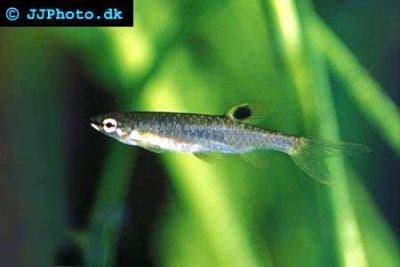



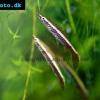 Brown
Brown 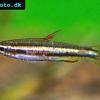 Dwarf
Dwarf 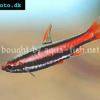 Coral-red
Coral-red 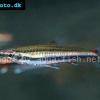 Threestripe
Threestripe